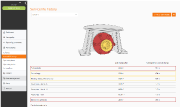In today’s manufacturing world the terms digital transformation and industrial digitization are being talked about a lot. Digitization is fundamentally changing our approach to everyday manufacturing operations across all industrial sectors. And for many companies, digitization has become a cornerstone of their product development activities. For example, Rösler Oberflächentechnik GmbH, a global leader in surface finishing technologies, is developing innovative software packages under the product name “Rösler Smart Solutions”. To learn more about how digitization is improving mass finishing and shot blasting operations, MFN sat down with Christian Hoehn, Head of the Technology Management Department at Rösler.
(?) MFN: Christian, it looks as if your company is fully committed to the digitization of mass finishing and shot blasting processes. Why else would you establish a new Rösler product line under the name “Rösler Smart Solutions”?
(!) C. H.: That is correct! We feel that with sophisticated digital tools, mass finishing and shot blasting operations can be substantially improved. But let me go back a bit: In the late 18th century we had an industrial revolution that was driven by mechanical inventions like the steam engine, the weaving loom and many more. With the advent of electrical power, the age of industrial mass production had arrived. The next milestone was the invention of the computer along with microprocessors, which gave a big boost to automation. And today, with the rapid development of elaborate digital tools we are fast approaching a point where artificial intelligence becomes a reality. For example, robots can self-diagnose their operation and issue reminders for preventive maintenance and part replacement. They are even able to warn about an impending component failure.
(?) MFN: How does this affect mass finishing and shot blasting. Both are fairly basic mechanical surface refinement methods.
(!) C. H.: To an outsider, both technologies appear to be quite simple. But whoever is working with them learns very quickly that they can be extremely complex requiring the consideration of many operating parameters. In addition, they are highly empirical and demand much knowledge and experience. And that is, where our digital “Rösler Smart Solutions” are coming in.
(?) MFN: How so?
(!) C. H.: To date the success of a mass finishing or shot blasting process depends to a large extent on the qualification and knowledge of the people developing and running it. A slight human error or oversight can wreck a finishing process and cost thousands of Dollars. By digitizing the control of the various operating parameters, the vagaries of the human factor can be neutralized. In other words, the quality management of mass finishing and shot blasting processes is transferred from humans to digital tools.
(?) MFN: Can you illustrate this with an example?
(!) C. H.: I can give you many practical examples. But let me explain our digitization goals a bit further: In place of humans evaluating a finishing process, strategically placed sensors are monitoring the operating parameters. The sensors report their readings to a computer programmed with special algorithms. These then analyze the readings, and if the data are off-track, the algorithms recommend specific corrective action, and at that moment, the machine operator must undertake these corrective actions, but we are working on systems where the corrections are done automatically. Of course, we are also working on software packages that provide clues for predictive maintenance.
(?) MFN: You have given us a lot to digest. How about some practical examples of your “Rösler Smart Solutions” successes.
(!) C. H.: Here is a good mass finishing example. For economic and ecological reasons, centrifuges play a dominant role in cleaning and recycling the process water from mass finishing processes. But maintaining such cleaning and recycling operations can be quite demanding; for example, stampings will carry different amounts of oil into a mass finishing machine. To get rid of the oil, the compound concentration in the process water might have to be adjusted frequently. At the same time, certain compounds also provide corrosion protection for the work pieces, but while a high compound concentration may be good for getting rid of the oil on the work pieces and protecting them against corrosion, it can be disastrous for subsequent coating processes. Such problems can cause a substantial amount of rework and, even, a high scrap rate.
What I am trying to say is that such process water cleaning and recycling operations can be very complicated, demanding the consideration and continuous adaptation of numerous process parameters.
(?) MFN: How will your “Rösler Smart Solutions” software help?
(!) C. H.: To date, the maintenance of process water recycling processes depended entirely on the knowledge and experience of the human operators. But people are bound to make mistakes, which can cause unwanted downtimes and cost thousands, even tens of thousands of Euros or Dollars by having to scrap entire work piece batches.
For this reason, we developed our innovative digital process water management system that evaluates all relevant process water parameters. This includes the compound concentration, the pH value, the water conductivity, the water hardness, the contamination with bacteria, the CSB value (chemical oxygen demand) and a few more. After the respective parameters have been measured and entered into the system, the algorithm in the software determines if their values are within the specified limits. In case of deviations the dashboard on a PC or tablet displays specific corrective actions that can be immediately implemented by the operator. The uncertainties of human process evaluation have therefore been completely eliminated and shifted to a digital tool.
(?) MFN: How are these parameter measurements done?
(!) C. H.: Until now, they have had to be done manually, but we are testing a system that utilizes suitable sensors allowing partly automatic measuring and recording of some of the process parameters.
(?) MFN: Can you tell us how this digital water management system helps the customers save money?
(!) C. H.: Numerous customers are already using the system. They particularly like its “early warning” function that helps prevent costly problems, such as downtimes, before they occur. The customers are also impressed by the substantially increased stability of their process water recycling operations. This has helped them to drastically decrease the amount of rework and reduce their scrap rate by 50%.
(?) MFN: Do you have similar “Rösler Smart Solutions” successes in shot blasting?
(!) C. H.: In shot blasting, we measure and monitor a wide range of process parameters such as the power consumption of the turbines, the blast media throughput per turbine, the proper function of the air wash separator, the proper function of all electrical components including actuators, and the overall consumption of blast media and use of compressed air.
Naturally, in shot blasting a special focus is also on predictive maintenance, especially for the blast turbines.
(?) MFN: You have mentioned a lot of parameters. But how do they fit into your digital management system?
(!) C. H.: Our software package is divided into three parts: (1) continuous process monitoring, (2) pro-active cost management, and (3) predictive maintenance.
Continuous monitoring and electronic storage of the shot-blast parameters helps to quickly find out when some of the parameters are outside the acceptable range. Whenever that is the case, immediate corrective actions can be taken. This helps to maintain a high shot-blast quality and minimizes unscheduled downtimes.
The recording of all consumptive data provides a complete cost overview and provides the basis for cost-saving adjustments of the shot blasting process. For example, the data might show that for certain work piece groups it is possible to throttle back the power to the turbines without jeopardizing the shot blasting quality. This can result in significant energy savings.
And finally, easy-to-understand digital displays show the service life history of the turbine wear components and provide an exact time frame for their replacement. This completely eliminates the need for time-consuming visual inspections and allows us to precisely schedule the replacement of the wear components. Therefore, unscheduled equipment downtimes can be completely prevented, the labor input for maintenance is substantially reduced, and the overall equipment availability is increased. Monitoring of the service history of the turbine components has proven to be a tremendous tool for predictive maintenance.
Continuous monitoring of the parameters of the blast process, the pro-active cost management and our predictive maintenance software are not only helping our customers to improve their shot blasting results but achieve substantial cost savings as well!
(?) MFN: Christian, you told us quite a bit about “Rösler Smart Solutions”. Where is this rapid digitization leading? Would you like to give us an outlook as your company sees it?
(!) C. H.: The digital era is not coming, it is here. To help our customers become more competitive, but also for our own company to remain competitive, we must meet this digital challenge head-on. Not too many years ago, typewriters were purely mechanical with literally hundreds of metal parts in every machine. This was a huge market for our company, because all these parts required some sort of surface finishing. But the situation changed drastically when the electric typewriter was developed, requiring no or only a few metal parts. Practically overnight, our company lost a big chunk of its business, and any typewriter manufacturer not adapting to the new situation quickly went out of business.
Today we are at a similar crossroads: Any company not exploiting the potential of digitization will be left behind. We at Rösler company will make sure that this will not happen to us!
MFN would like to thank Christian Hoehn for this interview!
For Information:
Rösler Oberflächentechnik GmbH
Vorstadt 1, 96190 Untermerzbach
Germany
Tel. +49.9533.924-802
Fax +49.9533.924-300
E-mail: d.hund@rosler.com































